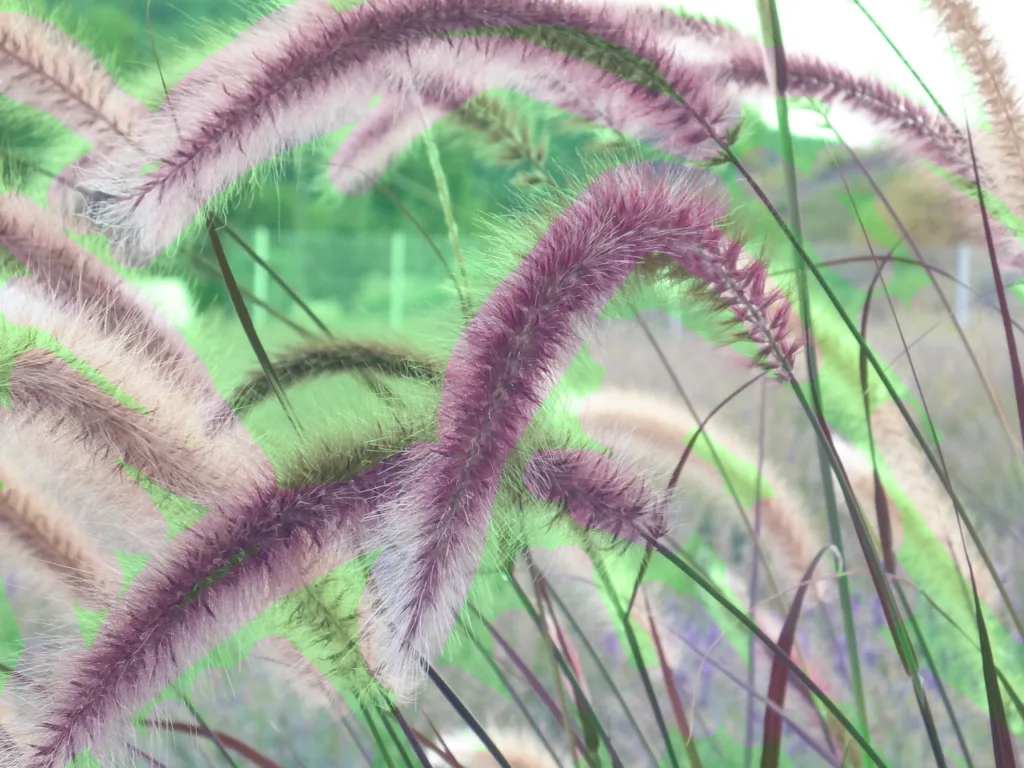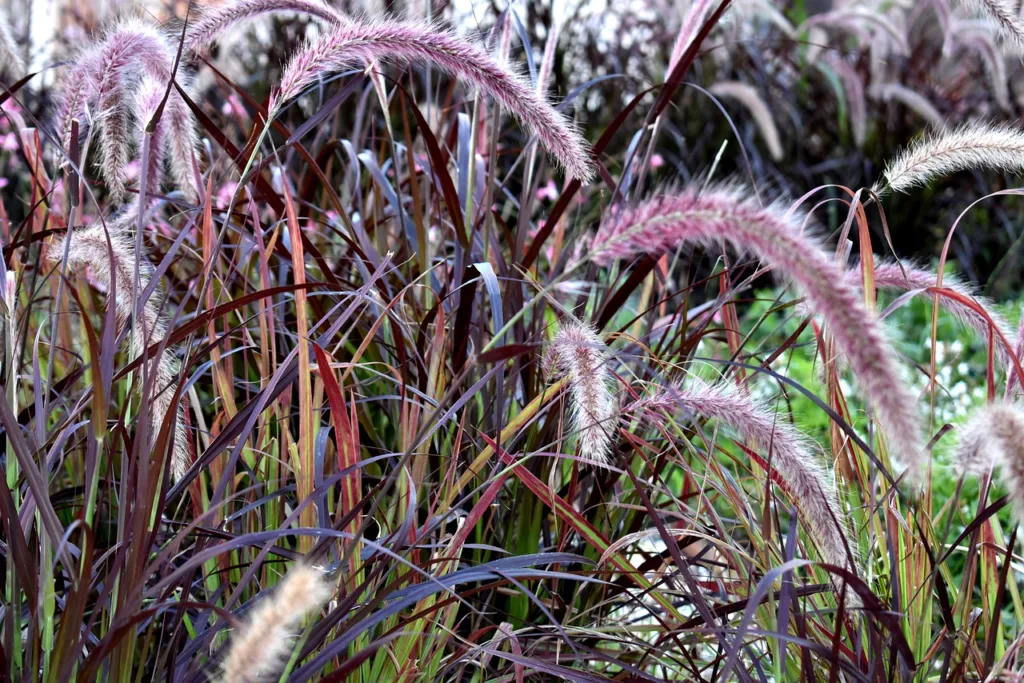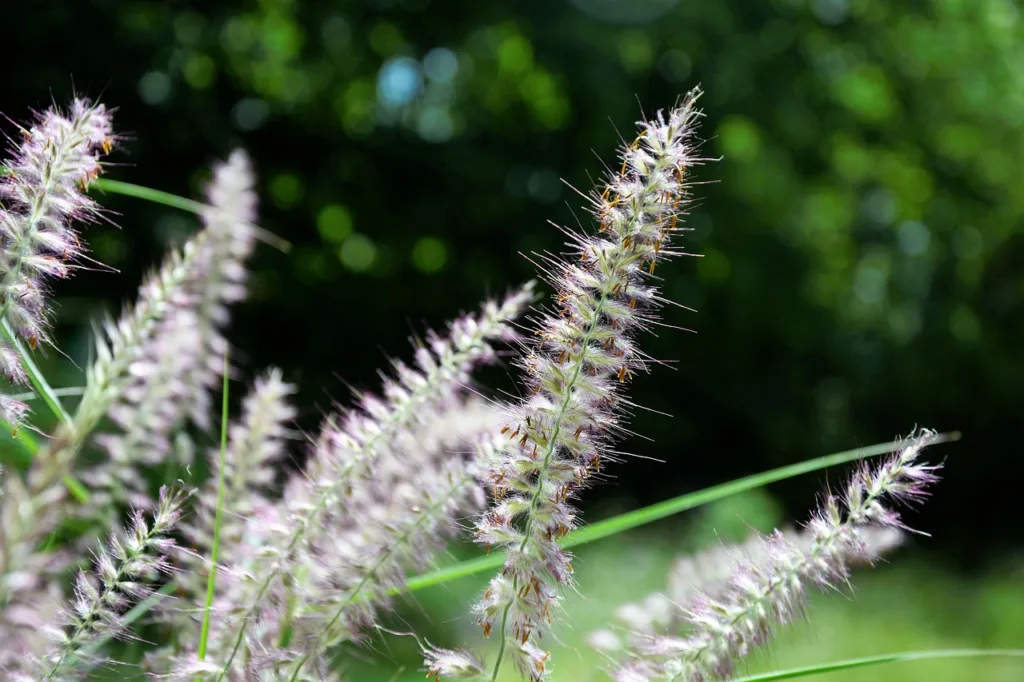Purple Fountain Grass, also known as Pennisetum setaceum ‘Rubrum,’ is a total stunner! Originally native to Africa and the Middle East and Poaceae (Grass family).
This Purple Fountain grass perennial plant is super popular and loved by everyone because of its cool arching stems and rad purple-red leaves.
It’s the perfect thing to add some elegance and poppin’ color to your garden, landscape, or container garden.
Let’s be real, it’s not just a plant – it’s a vibe. That purple-red color paired with the arching stems is so visually appealing, that you could stare at it all day long.
So yeah, if you want to add some sophistication and awesome looks to your outdoor space, Purple Fountain Grass is the way to go. It’s versatile, adaptable, and just all-around awesome!
| Characteristic | Description |
|---|---|
| Scientific Name | Pennisetum setaceum ‘Rubrum’ |
| Common Name | Purple Fountain Grass |
| Family | Poaceae (Grass family) |
| Type | Ornamental grass (Perennial) |
| Foliage Color | Burgundy-purple, visually striking |
| Plume Color | Creamy to red-burgundy, forming feathery, arching plumes |
| Height | Typically 3 to 4 feet, including plumes |
| Growth Habit | Clump-forming, with a graceful fountain-like shape |
| Sun Exposure | Prefers full sun for optimal growth and coloration |
| Soil | Well-draining soil preferred, adaptable to various types |
| Watering | Drought-tolerant once established, moderate water needs |
| Hardiness Zones | Typically grown in USDA Hardiness Zones 9-11; treated as an annual in colder zones |
| Landscape Use | Used as an accent plant in gardens, borders, containers, and landscaping for its ornamental foliage and plumes |
| Maintenance | Pruning to ground level in late winter or early spring to encourage fresh growth; dividing clumps every few years for rejuvenation |
| Invasive Concerns | In some regions, Purple Fountain Grass may be considered invasive, so check local regulations before planting |
Why Choose Purple Fountain Grass?
Before we dive into the nitty-gritty of growing and caring for purple fountain grass, let’s take a moment to appreciate why it’s worth adding to your garden or landscape. Here are a few compelling reasons:
Eye-catching color: The deep burgundy or purple foliage of purple fountain grass is a real showstopper. It creates a striking contrast when planted among greenery or paired with vibrant flowers.
Versatility: Purple fountain grass looks equally appealing as a standalone specimen or when mass-planted. It effortlessly adds texture, movement, and architectural interest to any garden design.
Low-maintenance: Once established, purple fountain grass requires minimal care. It can tolerate drought and is relatively pest-resistant, making it an easy-to-maintain choice for both novice and experienced gardeners.
Now that we have established the allure of purple fountain grass let’s delve into the details of how to grow and care for it.
| Does purple fountain grass come back? Yes, Purple Fountain Grass (Pennisetum setaceum ‘Rubrum’) is a perennial grass, and under the right conditions, it can come back every year. It is hardy in USDA Hardiness Zones 9-11, where winters are mild. In these zones, Purple Fountain Grass may maintain its foliage through the winter, or it might go dormant and then regrow in the spring. |

Planting Purple Fountain Grass
Like any other plant, purple fountain grass seed requires a suitable planting location and the right conditions to thrive. Here’s a step-by-step guide to successfully plant your purple fountain grass seeds:
Step 1: Choose the Right Spot
Purple fountain grass thrives in full sun, meaning it needs at least six hours of direct sunlight daily. Select a location in your garden or landscape that receives ample sunlight throughout the day.
Ensure that the soil is well-draining, as excessive moisture can cause root rot and other problems.
Step 2: Prepare the Soil
Before planting, prepare the soil by removing any weeds, rocks, or debris. Purple fountain grass prefers fertile soil with a slightly acidic to neutral pH range (6.0 to 7.0).
If your soil is heavy or clay-like, consider adding organic matter such as compost or well-rotted manure to improve its structure and drainage.
Step 3: Dig the Hole
Dig a hole slightly larger and deeper than the root ball of the grass. Gently loosen the roots of the plant, being careful not to damage them.
Step 4: Plant the Grass
Place the grass in the center of the hole, ensuring that the top of the root ball is level with the soil surface. Fill the hole with soil and gently tamp it down to eliminate air pockets. Water thoroughly to settle the soil around the roots.
Caring for Purple Fountain Grass
Now that your purple fountain grass is successfully planted, it’s time to learn how to care for it to ensure optimal growth and beauty. Let’s explore some essential aspects of caring for this vibrant ornamental grass.
Watering
While purple fountain grass is drought-tolerant once established, it benefits from regular watering during its initial growth period.
Newly planted grass should be watered deeply once or twice a week for the first month. Afterward, you can gradually reduce the frequency of watering to once every 1-2 weeks, especially during periods of prolonged drought.
Mulching
Applying a layer of mulch around the base of your purple fountain grass can help conserve moisture, suppress weeds, and regulate soil temperature.
Use organic mulch such as wood chips or straw and maintain a thickness of about 2-3 inches. However, be sure not to pile the mulch against the grass stems as it can lead to rotting.
Fertilizing
Feeding your purple fountain grass with a balanced slow-release fertilizer in spring can promote healthy growth and vibrant foliage.
Follow the manufacturer’s instructions regarding the dosage and frequency of application. However, avoid over-fertilizing, as excessive nitrogen may result in lush foliage but fewer flowers.
Pruning
Purple fountain grass benefits from an annual pruning in early spring before new growth emerges. Cut the grass back to a few inches above the ground, removing any dead or damaged foliage. This process helps rejuvenate the plant, improves its appearance, and encourages fresh growth.
Managing Pests and Diseases
Purple fountain grass is generally resistant to pests and diseases. However, occasional problems such as aphids, slugs, or fungal leaf spot can occur.
Monitor your grass regularly and take appropriate action if you notice any signs of infestation or disease. Consider using organic insecticides or fungicides as a first line of defense, and always follow the instructions provided.
Overwintering
In regions with mild winters, purple fountain grass may remain evergreen. However, if you live in an area with freezing temperatures, you have two options to protect your grass during winter:
Leave it as is: Some gardeners choose to leave the grass standing to provide winter interest and protection for the crown. However, be aware that extreme cold can still damage the foliage.
Cut it back: Alternatively, you can cut the grass back to a few inches above the ground after it goes dormant in late fall. Mulch around the base to insulate the crown and protect it from freezing temperatures. Remove the mulch in early spring before new growth emerges.

| is purple fountain grass invasive? It’s worth noting that purple fountain grass can be invasive in some areas, especially in hot climates. Check with local officials or gardening experts to make sure it’s suitable for your specific location. Purple fountain grass is a versatile and eye-catching addition to the landscape, providing a burst of color and beauty. With its low-maintenance nature and charming visual appeal, it has become a favorite choice among gardeners who want to enhance the beauty of their outdoor spaces. |
Types of Purple Fountain Grass
- Pennisetum setaceum ‘Rubrum’:
- The standard and most commonly grown Purple Fountain Grass with burgundy-purple foliage and feathery plumes.
- Pennisetum setaceum ‘Fireworks’:
- A dwarf variety known for its compact size and multi-colored foliage, featuring shades of burgundy, pink, and green.
- Pennisetum setaceum ‘Skyrocket’:
- This cultivar has a more upright growth habit, and its plumes emerge with a distinctive pinkish tint before maturing to a creamy color.
- Pennisetum setaceum ‘Cupreum’:
- Notable for its coppery-bronze foliage, adding a warm and rich color to the landscape.
- Pennisetum setaceum ‘Burgundy Bunny’:
- Another dwarf cultivar with a more compact size, suitable for smaller spaces or container gardens.
- Pennisetum setaceum ‘Cherry Sparkler’:
- Features variegated foliage with white and green stripes, creating a unique and eye-catching appearance.
Final Thoughts
Growing and caring for purple fountain grass can be a rewarding experience. Its striking colors and graceful form add elegance and visual interest to any garden or landscape.
By choosing the right planting spot, providing proper care, and ensuring suitable overwintering practices, you can enjoy the beauty of this stunning ornamental grass for seasons to come. So, why wait? Add some purple flair to your garden and let your purple fountain grass steal the show!
People Also Ask
Is there a dwarf purple fountain grass?
Yes, there are dwarf varieties of Purple Fountain Grass available, such as Pennisetum setaceum ‘Rubrum Dwarf’ or ‘Fireworks.’ These cultivars exhibit the characteristic burgundy-purple foliage and plumes but on a more compact scale.
Is purple fountain grass a foxtail?
Purple Fountain Grass (Pennisetum setaceum ‘Rubrum’) is not commonly referred to as a foxtail. The term “foxtail” is often associated with various grass species that produce spike-like flowering structures, resembling a fox’s tail.
While both Purple Fountain Grass and foxtails belong to the grass family (Poaceae), they are distinct in appearance and characteristics.
Where is the best place to plant purple fountain grass?
Purple Fountain Grass thrives in full sun, so the best place to plant it is in a location that receives abundant sunlight.
Well-draining soil is preferred, and it can be used in various landscaping settings, including gardens, borders, and containers.
What is another name for purple fountain grass?
Purple Fountain Grass is commonly known by its botanical name, Pennisetum setaceum ‘Rubrum.’ While it is often referred to simply as Purple Fountain Grass, the term “fountain grass” is also used to describe various ornamental grasses with fountain-like growth habits.
Where is the best place to plant purple fountain grass?
The best place to plant Purple Fountain Grass is in a sunny location with well-draining soil. It is often used in gardens, borders, and containers to add ornamental value with its vibrant foliage and plumes.
Ensure it is planted in a region where it is not considered invasive, and local regulations are followed.

